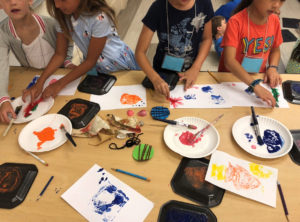This week on the blog, Education Intern Alle Permenter shares her experience working with summer camp this year at the Gibbes!
I am a rising senior at the College of Charleston, majoring in early-childhood education with a minor in studio art and I just finished my Educational Internship at the Gibbes Museum of Art. My experience at the Gibbes was unforgettable and I am so grateful to have this opportunity. This internship confirmed my love not only for children, but for art. It is so inspiring to see young minds learning about techniques, artists, and using mediums that I did not learn when I was their age. I have learned so much during my time at the Gibbes. The museum was the perfect place for me; I felt right at home in the happy and creativity-inspiring environment.
In my three weeks at the Gibbes, I observed art created from inspired topics such as France, science, and animals. Art ranging from Edgar Degas to Josh Brown, who is a local artist here in Charleston. I am so grateful to have had the chance to help teach children about these artists and see the awe-inspiring looks on their faces. I have seen children gain confidence in their art from Monday to Friday each week, which was my favorite part of the experience.
I got the opportunity to work beside a wonderful teacher and artist, Fallon Peper, who allowed me to teach a lesson. I decided to teach the children Gyotaku printmaking, one of my favorite art forms, using recycled materials. This lesson highlighted fine arts and infused a core science. I love teaching lessons that implement different topics through the use of art, so this was perfect! I started the lesson by informing the campers about Gyotaku, which is a traditional Japanese method of printing fish. It is a practice that dates back to the mid-1800s. Students used recycled and natural materials to create their versions of prints. Foam plates were used for the printmaking and pencils to do the carving. The campers also used Earth’s natural resources (rocks and seashells) to create printmaking; this compared natural to man-made mediums. This allowed the campers to learn the importance of reducing trash through reusing materials for art.I am humbled and thankful for this experience.

I want to thank Becca Hiester and everyone at the Gibbes for this opportunity. I have grown as a student, teacher, and art educator through communication and classroom management skills I gained at the Gibbes Museum. I have learned so much from this experience and realized that I am studying the right field for me. I cannot wait to use everything I have learned in my own classroom one day!
-Alle Permenter, guest blogger and Education Intern
Published July 18, 2019
Top image: Alle and a summer camper here at the Gibbes

